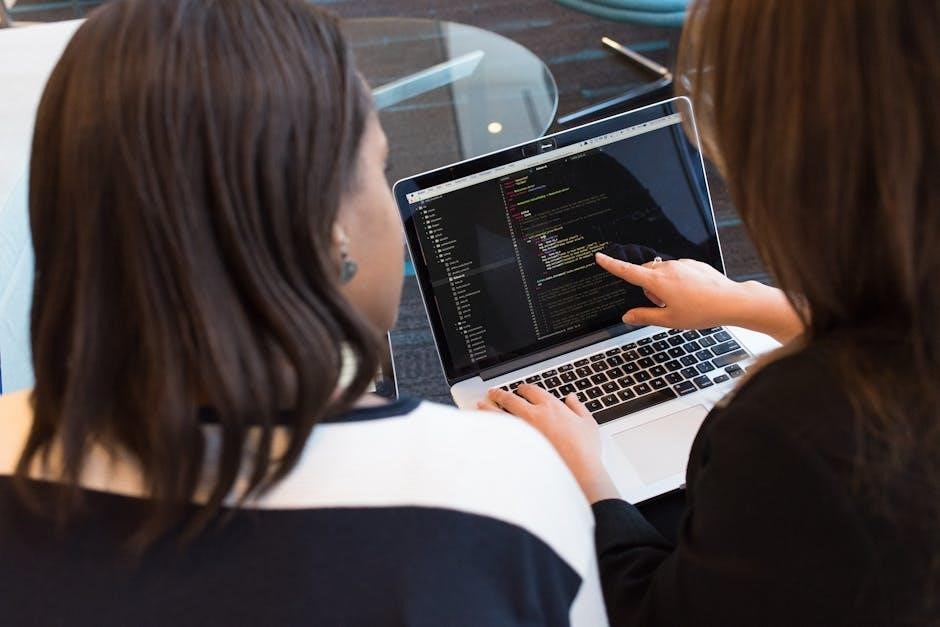Behavioral interviews are a cornerstone in software engineering hiring, assessing candidates’ past experiences to predict future performance․ By using the STAR method, candidates structure responses effectively, showcasing problem-solving skills and alignment with company values․ This guide explores common questions, preparation strategies, and tips to excel in these interviews, ensuring a comprehensive understanding of what to expect and how to succeed․
What Are Behavioral Interviews?
Behavioral interviews focus on assessing a candidate’s past experiences to predict future behavior in similar situations․ These interviews typically involve questions that begin with prompts like “Tell me about a time when․․․” or “Describe a situation where․․․”․ The goal is to evaluate skills such as problem-solving, teamwork, leadership, and adaptability․ In software engineering, behavioral interviews are crucial for understanding how candidates handle technical challenges, collaborate with teams, and learn from mistakes․ Employers use these insights to determine if a candidate aligns with the company’s culture and values․ The STAR method (Situation, Task, Action, Result) is often recommended for structuring effective responses to these types of questions․
Importance of Behavioral Interviews in Software Engineering
Behavioral interviews are crucial in software engineering as they allow employers to assess a candidate’s past experiences and how they may perform in future roles․ These interviews help evaluate problem-solving skills, teamwork, and adaptability, which are essential for success in technical environments․ By understanding how candidates handle challenges, collaborate with others, and learn from mistakes, employers can better align candidates with the company’s culture and values․ Behavioral interviews also provide insights into a candidate’s passion for software engineering and their ability to grow within the organization․ The STAR method is often used to structure responses, ensuring clarity and effectiveness in showcasing relevant experiences․

Preparation Strategies for Behavioral Interviews
Preparation involves self-assessment, researching company culture, and practicing responses using the STAR method․ Aligning experiences with the role and company values ensures a tailored approach to interviews․
Researching the Company Culture
Understanding a company’s culture is crucial for behavioral interviews․ It helps align your values and behaviors with theirs, showcasing your fit․ Start by visiting the company’s website, reviewing mission statements, and exploring blogs or news articles; Social media platforms like LinkedIn or Twitter can provide insights into their work environment․ Additionally, sites like Glassdoor offer employee testimonials, revealing cultural nuances․ Analyze their core values and recent projects to identify patterns․ This research enables you to tailor your responses, emphasizing experiences that align with their culture․ For instance, if innovation is a key value, highlight situations where you introduced new ideas․ Demonstrating this alignment enhances your credibility and enthusiasm during the interview․
Practicing with Sample Behavioral Questions
Practicing with sample behavioral questions is essential for software engineers preparing for interviews․ Review common questions like “Tell me about a technical challenge you faced” or “Describe a project you led․” Use the STAR method to structure your responses, ensuring clarity and conciseness․ Mock interviews or role-playing with peers can simulate real scenarios, helping you refine delivery․ Tailor each answer to highlight relevant skills and experiences, demonstrating problem-solving abilities and teamwork․ Regular practice builds confidence and reduces nervousness, allowing you to articulate your thoughts effectively during actual interviews․ This preparation ensures you present yourself as a capable and thoughtful candidate, ready to contribute to the company’s success․
Reviewing Your Past Experiences
Reviewing your past experiences is crucial for behavioral interviews, as they often focus on how you handled specific situations․ Identify key projects, challenges, and achievements that highlight your skills and problem-solving abilities․ Reflect on your role in team settings, decisions you made, and the outcomes of your actions․ Quantify accomplishments where possible to demonstrate impact․ Organize these experiences in a way that aligns with the company’s values and the role’s requirements․ This preparation enables you to deliver confident, concise responses during the interview, showcasing your relevance for the position․ By linking your past actions to future potential, you illustrate how your experiences make you a strong fit for the role․
Understanding the Role of a Software Engineer
Understanding the role of a software engineer is essential for behavioral interviews, as it allows you to align your experiences with the company’s expectations․ Research the key responsibilities, such as coding, problem-solving, and collaboration, to demonstrate how your skills match the job․ Familiarize yourself with the company’s specific needs and technologies to show your enthusiasm for the position․ Review common software engineering challenges and think about how you’ve tackled similar issues in the past․ This preparation helps you connect your experiences to the role’s requirements, showcasing your readiness to contribute effectively․ By understanding the role deeply, you can confidently highlight your relevance and alignment with the company’s goals․
Common Behavioral Interview Questions
Behavioral interviews for software engineers often include questions like “Tell me about a technical challenge you overcame” or “Describe a project you led․” These questions help employers assess your problem-solving skills and cultural fit, ensuring you align with their team and values; Being prepared with specific examples from your experience is key to standing out․ These inquiries are designed to evaluate how you handle real-world scenarios, making them crucial for showcasing your qualifications and mindset․ By understanding these common questions, you can tailor your responses to highlight your strengths effectively․
Tell Me About a Time You Faced a Technical Challenge
This question is designed to evaluate your problem-solving skills and ability to handle pressure․ When answering, use the STAR method to structure your response: describe the Situation, your Task, the Actions you took, and the Result․ Be specific about the challenge, your role, and the outcome․ For example, discuss a complex bug you debugged, a system optimization you achieved, or a project where you overcame technical limitations․ Highlight your critical thinking, creativity, and resilience․ The goal is to show how you approached the problem, what you learned, and how it demonstrates your capabilities as a software engineer․ A clear, concise narrative will make your answer impactful and memorable․
Describe a Project You Led and Its Outcome
This question allows interviewers to assess your leadership skills, decision-making, and ability to deliver results․ Choose a project where you played a key role, outlining your responsibilities and the challenges faced․ Use the STAR method to structure your response: describe the Situation, your Task, the Actions you took, and the Result․ Highlight collaboration with team members, problem-solving strategies, and the project’s impact․ For example, discuss how you guided the development of a feature, overcame technical hurdles, and delivered it on time․ Emphasize the outcome, such as improved performance or user satisfaction․ Show how your leadership contributed to the project’s success and what you learned from the experience․
How Do You Handle Conflict in a Team?
Conflict resolution is crucial in team dynamics, especially in software engineering․ When faced with disagreement, I prioritize understanding perspectives through active listening․ I focus on identifying common goals and fostering open communication to align the team․ By addressing issues constructively, I ensure conflicts become opportunities for growth․ For example, in a project where opinions clashed on the approach, I mediated discussions, helping the team reach a consensus․ This collaboration not only resolved the conflict but also strengthened our teamwork․ The outcome was a cohesive strategy that met project requirements and enhanced our collective problem-solving skills․ Effective conflict management is about turning challenges into solutions that benefit everyone․
Explain a Situation Where You Learned from a Mistake
In one project, I mistakenly deployed a feature without thoroughly testing it, leading to unexpected bugs in production․ This oversight caused temporary downtime and required immediate attention from the team․ I took responsibility, collaborated with colleagues to identify the root cause, and worked tirelessly to resolve the issue․ Through this experience, I learned the importance of rigorous testing and cross-verification before deployment․ I implemented a pre-deployment checklist and emphasized the value of teamwork in addressing errors․ This mistake taught me to prioritize attention to detail and proactive problem-solving, ensuring higher quality outputs in subsequent projects․ It reinforced my commitment to continuous improvement and accountability in software engineering․
Can You Share an Example of a Difficult Decision You Made?
In a previous project, I faced a critical decision when a key feature I developed encountered a major bug just before the release deadline․ After assessing the situation, I decided to delay the release to fix the bug, despite the pressure to meet the timeline․ This decision required balancing the urgency of the release with the potential consequences of deploying faulty software․ I collaborated with my team to prioritize bug fixes and implemented additional testing safeguards․ The outcome was a successful release with minimal issues, earning stakeholder trust․ This experience taught me the importance of standing by quality and communicating clearly during tough decisions, even when it means facing short-term setbacks․

The STAR Method for Answering Questions
The STAR framework helps structure responses to behavioral questions by detailing the Situation, Task, Action, and Result․ This method ensures clarity and highlights problem-solving skills effectively․
What is the STAR Framework?
The STAR framework is a structured method for answering behavioral interview questions effectively․ It stands for Situation, Task, Action, and Result․ This approach helps candidates organize their responses clearly, ensuring they provide specific examples from their past experiences․ By breaking down each component—describing the context (Situation), the problem or goal (Task), the steps taken to address it (Action), and the outcome achieved (Result)—candidates can showcase their problem-solving skills and decision-making abilities․ This method is widely recommended for software engineers, as it aligns with the technical and collaborative nature of the role, making it easier for interviewers to assess a candidate’s fit for the position․
How to Apply STAR to Behavioral Questions
Applying the STAR framework to behavioral questions involves breaking down your response into four clear sections: Situation, Task, Action, and Result․ Start by setting the context with the Situation, describing the background or circumstances of the event․ Next, outline the Task, explaining the specific challenge or responsibility you faced․ Then, detail the Action you took, focusing on your contributions and decisions․ Finally, conclude with the Result, highlighting the outcomes of your efforts, such as achievements or lessons learned․ This structured approach ensures clarity and effectiveness, making it easier for interviewers to understand your problem-solving skills and decision-making abilities․ By using STAR, you can deliver concise, impactful responses to behavioral questions․
Example of STAR in Action
An example of the STAR method in action could involve a question like, “Tell me about a time you faced a technical challenge․” In the Situation, you might describe working on a project with a tight deadline when a critical bug emerged․ For the Task, explain how you were responsible for identifying and resolving the issue․ In the Action section, detail your approach, such as collaborating with team members, debugging, or implementing a solution․ Finally, in the Result, share the outcome, like successfully fixing the bug and delivering the project on time, and reflect on what you learned․ This structured approach ensures a clear and compelling response․
Company-Specific Behavioral Questions
Company-specific behavioral questions assess how well candidates align with a company’s culture and values․ These questions help employers evaluate a candidate’s fit for the role and organization, often including examples like ‘Why do you want to work here?’ and ‘How do you align with our values?’
Why Do You Want to Work Here?
This question assesses your alignment with the company’s mission and values․ Highlight specific aspects of the company, such as its innovative culture, collaborative environment, or impactful projects․ Demonstrate enthusiasm by mentioning how the company’s goals resonate with your personal and professional aspirations․ For example, you might discuss its reputation for fostering growth, its commitment to cutting-edge technology, or its focus on solving real-world problems․ Emphasize how your skills and experiences make you a strong fit for the role and the organization․ Show genuine interest and preparation by referencing the company’s achievements or values that excite you․ This response should reflect thoughtful research and a clear connection to the company’s identity․
How Do You Align with Our Company Values?
Aligning with company values is crucial for cultural fit and long-term success․ Research the organization’s core values, such as innovation, teamwork, or customer focus, and connect them to your past experiences․ For example, if the company values innovation, share a story where you introduced a new idea or improved a process․ If collaboration is key, describe a project where your teamwork led to a successful outcome․ Highlight specific instances where your actions mirrored the company’s values, demonstrating how you embody them․ Be genuine and specific, showing how your approach to work and problem-solving reflects the organization’s principles․ This proves you’re not only qualified but also a natural fit for the company’s culture and mission․

Red Flags to Avoid in Behavioral Interviews
Avoid negative attitudes toward past employers, lack of enthusiasm for the role, and unpreparedness․ These red flags can undermine your credibility and fit for the position․
Negative Attitudes Towards Past Employers
Negative remarks about former employers or colleagues can raise concerns about professionalism and interpersonal skills․ Speaking poorly of past workplaces may indicate a lack of accountability or maturity․ Employers seek candidates who maintain positivity and discretion, even when discussing challenging experiences․ Criticizing previous employers excessively can create doubts about your ability to work collaboratively or fit into the company culture․ It’s essential to focus on lessons learned rather than assigning blame․ For example, instead of saying, “My last boss was terrible,” you could say, “I learned the importance of clear communication in my previous role․” This approach demonstrates growth without appearing unprofessional or resentful․
Lack of Enthusiasm for the Role
A lack of enthusiasm during a behavioral interview can signal disinterest or poor motivation․ Employers seek candidates who are passionate about the role and eager to contribute․ Displaying indifference or failing to ask insightful questions can raise doubts about your commitment․ For example, responding vaguely to questions about your goals or showing little excitement about the company’s projects can harm your candidacy․ To avoid this, prepare thoughtful questions and highlight specific aspects of the role that align with your skills and interests․ Sharing personal anecdotes or projects you’re passionate about demonstrates genuine engagement․ Enthusiasm not only builds rapport but also shows that you’re motivated to excel in the position․
Unpreparedness for the Interview
Unpreparedness for a behavioral interview is a significant red flag, as it suggests a lack of seriousness about the opportunity․ Candidates who fail to research the company, practice common questions, or align their experiences with the role may appear unprofessional or disinterested․ For instance, not knowing the company’s mission or values can make it seem like you’re not genuinely interested in the position․ Similarly, being unable to provide structured answers using the STAR method or failing to prepare thoughtful questions for the interviewer can leave a negative impression․ Unpreparedness not only wastes the interviewer’s time but also undermines your credibility, making it less likely for you to advance in the hiring process․

Tips for Acing Behavioral Interviews

Be specific with examples, highlight problem-solving skills, and demonstrate passion for software engineering․ Use positive body language and send a follow-up thank-you email to leave a lasting impression․
Be Specific with Your Examples
When answering behavioral interview questions, being specific with your examples is crucial․ This helps interviewers understand your role, skills, and impact in past situations․ Avoid vague statements like “I helped the team succeed” and instead provide detailed accounts of challenges, actions, and outcomes․ For instance, describe a specific project, the problem you faced, the steps you took to resolve it, and the measurable results․ Use the STAR method to structure your responses: Situation, Task, Action, Result․ This approach ensures clarity and demonstrates your problem-solving abilities․ For example, “In a project where our team faced a critical deadline, I optimized the code, reducing runtime by 30%․” Being specific showcases your expertise and makes your stories more credible and impactful․
Highlight Your Problem-Solving Skills
In behavioral interviews for software engineering roles, showcasing your problem-solving skills is essential․ Employers want to see how you approach challenges, think critically, and deliver solutions․ When answering questions, emphasize your analytical thinking, logical reasoning, and creativity in tackling technical issues․ For example, describe a situation where you debugged complex code, optimized performance, or resolved a system bottleneck․ Be specific about the steps you took, the tools you used, and the outcomes achieved․ Highlighting how you broke down the problem, identified key factors, and implemented an effective solution demonstrates your technical prowess and ability to handle real-world scenarios․ This not only illustrates your expertise but also your capacity to contribute meaningfully to the team and projects․
Demonstrate Passion for Software Engineering
Demonstrating genuine passion for software engineering is crucial during behavioral interviews․ Share personal anecdotes about projects you’ve led, challenges you’ve overcome, or innovations you’ve pioneered․ Highlight how your enthusiasm drives your commitment to continuous learning and staying updated with industry trends․ Discuss how you’ve contributed to open-source projects or mentored junior developers, showcasing your dedication to the field․ Express excitement about the company’s mission and how your values align with theirs․ Employers want to hire not just skilled engineers but individuals who are genuinely passionate about solving problems and creating impactful solutions․ Your passion will set you apart and show that you’re invested in growing with the team and contributing meaningfully to the organization’s success․
Use Body Language to Your Advantage
Body language plays a significant role in behavioral interviews, as it conveys confidence and engagement․ Maintain eye contact to show sincerity and attentiveness․ Sit up straight and avoid slouching, as this demonstrates professionalism․ Use open gestures like uncrossing your arms to signal approachability; Nodding occasionally shows you’re actively listening․ Mirroring the interviewer’s posture subtly can build rapport․ A smile can make you appear friendly and enthusiastic․ Avoid fidgeting or crossing your legs, as these may indicate nervousness․ Positive body language complements your verbal responses, making you appear more credible and passionate about software engineering․ By being mindful of your nonverbal cues, you can create a stronger, more lasting impression during the interview․
Send a Follow-Up Thank You Email
Sending a follow-up thank you email after a behavioral interview is a professional courtesy that leaves a lasting positive impression․ Aim to send it within 24 hours, expressing gratitude for the opportunity and reiterating your interest in the role․ Mention specific topics discussed during the interview to show you were attentive and engaged․ Personalize the email by referencing the company’s values or projects that excite you․ Keep the tone professional yet personable, ensuring it reflects your enthusiasm for the position․ A well-crafted thank you email not only demonstrates politeness but also reinforces your suitability for the software engineering role, keeping you top of mind for the hiring team․

Resources for Further Reading
Explore recommended books on behavioral interviews, enroll in online courses for tailored preparation, and utilize PDF guides with practical exercises to refine your skills effectively․
Recommended Books on Behavioral Interviews
Enhance your preparation with books like “Cracking the Coding Interview” and “The STAR Method”, which offer insights into acing behavioral interviews․ “Behavioral Interviews: A Guide to Success” provides practical strategies and examples tailored for software engineers․ These resources cover essential topics like answering technical challenges, showcasing problem-solving skills, and aligning with company values․ They also include tips on using the STAR framework effectively and demonstrating passion for software engineering․ Additionally, books like “Interviews That Work” focus on real-world scenarios and how to present your experiences confidently․ These books are invaluable for understanding company cultures and preparing thoughtful responses, ensuring you stand out in your interviews․
Online Courses for Interview Preparation
Online courses are an excellent way to prepare for behavioral interviews, offering structured learning and practical insights․ Platforms like Coursera, Udemy, and LinkedIn Learning provide courses specifically designed for software engineers․ These courses cover topics such as mastering behavioral questions, understanding company cultures, and applying the STAR method effectively․ Many courses include video lessons, mock interviews, and interactive exercises to simulate real interview scenarios․ They also focus on developing soft skills like communication and problem-solving, which are crucial for success in behavioral interviews․ By enrolling in these courses, candidates can gain confidence, refine their responses, and learn how to highlight their experiences effectively, ensuring they are well-prepared to ace their interviews․
PDF Guides and Worksheets
PDF guides and worksheets are invaluable resources for preparing for behavioral interviews․ Many companies and career services offer downloadable PDFs that outline common questions, provide sample answers, and include exercises to help candidates refine their responses․ These guides often focus on specific aspects of behavioral interviewing, such as using the STAR method or aligning answers with company values․ Worksheets may include templates for organizing thoughts, brainstorming past experiences, and practicing answers in a structured format․ Platforms like GitHub, career websites, and company portals frequently share these resources, making them easily accessible for software engineers to improve their interview readiness and confidence․ Utilizing these tools can significantly enhance one’s ability to articulate experiences effectively during interviews․
Mastering behavioral interviews requires preparation, self-reflection, and practice․ By leveraging the STAR method, aligning with company values, and showcasing problem-solving skills, software engineers can excel in these interviews and secure their desired roles․
Behavioral interviews for software engineers focus on assessing past experiences to predict future performance․ Key strategies include researching company culture, practicing with sample questions, and using the STAR method to structure responses․ Highlighting problem-solving skills, passion for engineering, and alignment with company values is crucial․ Avoid negative attitudes, lack of enthusiasm, and unpreparedness, as these are red flags․ Demonstrating specific examples, showcasing teamwork, and learning from mistakes are essential․ Preparation, confidence, and enthusiasm significantly impact success․ By mastering these elements, candidates can effectively showcase their qualifications and fit for the role, ultimately acing their behavioral interviews․
Final Thoughts on Mastering Behavioral Interviews
Mastering behavioral interviews requires confidence, preparation, and authenticity․ By aligning your experiences with the STAR framework and showcasing problem-solving skills, you demonstrate your value as a software engineer․ Highlighting passion for the role and enthusiasm for the company culture leaves a lasting impression․ Avoid negativity and focus on growth from past challenges․ Continuous practice and self-reflection ensure readiness for any question․ Remember, authenticity and alignment with company values are key to standing out․ With dedication and the right strategies, you can confidently navigate behavioral interviews and position yourself as an ideal candidate for the role․ Keep improving and stay proactive in your preparation journey․


